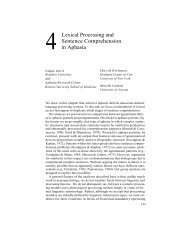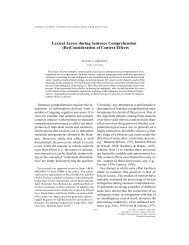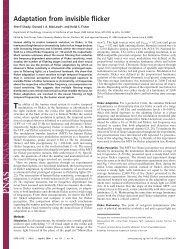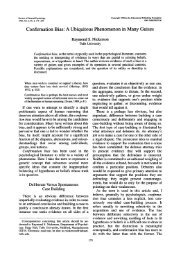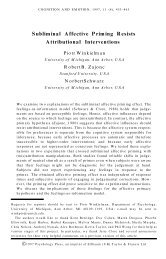Chapter 9 Moving verbs in agrammatic production
Chapter 9 Moving verbs in agrammatic production
Chapter 9 Moving verbs in agrammatic production
Create successful ePaper yourself
Turn your PDF publications into a flip-book with our unique Google optimized e-Paper software.
162 Grammatical disorders <strong>in</strong> aphasi a<br />
But the po<strong>in</strong>t rema<strong>in</strong>s the same: when a verb is produced correctly<br />
<strong>in</strong>flected, it has moved up and therefore it appears before the adverb.<br />
When it appears <strong>in</strong> the <strong>in</strong>f<strong>in</strong>itive, both when the <strong>in</strong>f<strong>in</strong>itive is required and<br />
when an <strong>in</strong>flected verb is required, it appears <strong>in</strong> the <strong>in</strong>f<strong>in</strong>itival position.<br />
Another critical case where the relation between verb <strong>in</strong>flection and<br />
verb position can be exam<strong>in</strong>ed empirically is verb second Germanic<br />
languages. In many Germanic languages (such as Dutch, German,<br />
Icelandic and Scand<strong>in</strong>avian languages), the f<strong>in</strong>ite verb moves to the<br />
second position of the clause, after the first constituent - be it the subject,<br />
as <strong>in</strong> (5) or any other constituent as <strong>in</strong> (6).<br />
SVO<br />
5. de jongen loopt op straat<br />
the boy walks on street<br />
XP VSO<br />
6. langzaam loopt de jongen op straat<br />
slowly walks the boy on street<br />
Whereas f<strong>in</strong>ite <strong>verbs</strong> move to second position, non-f<strong>in</strong>ite <strong>verbs</strong> (participles<br />
and <strong>in</strong>f<strong>in</strong>itives), do not move and stay <strong>in</strong> f<strong>in</strong>al position, as seen <strong>in</strong> the<br />
sentences for German (7) and Dutch (8): 4<br />
7. a. V f<strong>in</strong> 2nd: Konrad schaute aus dem Fenster.<br />
Konrad looked out of the w<strong>in</strong>dow<br />
b. V <strong>in</strong>t f<strong>in</strong>al: Konrad will aus dem Fenster schaucn.<br />
Konrad wants out of the w<strong>in</strong>dow look-<strong>in</strong>f<br />
8. a. V f<strong>in</strong> 2nd: De boer melkt de koe<br />
the farmer milks the cow<br />
b. V <strong>in</strong>t f<strong>in</strong>al: De boer wil de koe melken<br />
the farmer wants the cow milk-<strong>in</strong>f<br />
V2 is a movement from V° to C 0 (through 1 0 ). This is the reason for the<br />
difference <strong>in</strong> V2 languages between matrix and embedded clauses with<br />
respect to verb position: <strong>in</strong> embedded sentences the C node is already<br />
occupied by a complementizer, and therefore the verb cannot raise to C,<br />
and stays down <strong>in</strong> f<strong>in</strong>al position, as seen <strong>in</strong> sentence (9) <strong>in</strong> German. This<br />
is one of the most illustrative examples of the close connection between<br />
functional categories, head movement and verbal <strong>in</strong>flection.<br />
9. Es ist ke<strong>in</strong> Wunder, dass sich Onkel R<strong>in</strong>gelhuth fiber nichts wunderte.<br />
It is no wonder, that himself uncle R<strong>in</strong>gethuth over noth<strong>in</strong>g wondered..<br />
<strong>Mov<strong>in</strong>g</strong> <strong>verbs</strong> <strong>in</strong> <strong>agrammatic</strong> <strong>production</strong> 163<br />
Consider how this might serve as one of the crucial tests for evaluat<strong>in</strong>g the<br />
accounts of <strong>in</strong>f<strong>in</strong>itive use <strong>in</strong> agrammatism: a tree prun<strong>in</strong>g account which<br />
entails no verb movement to T (and therefore also no subsequent<br />
movement to C) predicts that <strong>in</strong> V2 languages, the <strong>in</strong>f<strong>in</strong>itive will not<br />
appear <strong>in</strong> second position but <strong>in</strong> f<strong>in</strong>al position. That is - whenever a verb<br />
appears <strong>in</strong> its non-f<strong>in</strong>ite form, and crucially, also when it appears <strong>in</strong>appropriately<br />
non-f<strong>in</strong>ite <strong>in</strong>stead of f<strong>in</strong>ite, it should appear <strong>in</strong> the structural<br />
location of the non-f<strong>in</strong>ite forms - namely <strong>in</strong> its base-generated node (or<br />
after short movement to AGR to check Agreement features) at the end of<br />
the sentence. On the other hand, no consequence for word order derives<br />
from non-structural accounts: accounts of 'morphological' <strong>in</strong>flectional<br />
deficit predict a use of 'least effort' or 'default' form <strong>in</strong> the same sentential<br />
position of the required f<strong>in</strong>ite verb.<br />
Data from structured tests and spontaneous speech <strong>in</strong> Germanic V2<br />
languages verify the TPH prediction: when an <strong>in</strong>f<strong>in</strong>itive is used even<br />
<strong>in</strong>stead of a f<strong>in</strong>ite verb <strong>in</strong> matrix clause, it is almost always <strong>in</strong> f<strong>in</strong>al position.<br />
This has been found for Dutch and German, and some <strong>in</strong>dications for verb<br />
position implication were also found for Swedish and Icelandic.<br />
A study recently conducted by Bastiaanse and Van Zonneveld (1998)<br />
exam<strong>in</strong>ed the question of the relation between f<strong>in</strong>iteness and verb<br />
position. In this study, ten Broca's aphasics were required to complete<br />
sentences with a verb miss<strong>in</strong>g either <strong>in</strong> second or <strong>in</strong> f<strong>in</strong>al position, <strong>in</strong><br />
matrix or embedded clause.<br />
The results show that <strong>agrammatic</strong>s have a hard time produc<strong>in</strong>g <strong>verbs</strong> <strong>in</strong><br />
the moved position (second position), but they do not have problems<br />
produc<strong>in</strong>g <strong>verbs</strong> <strong>in</strong> their base-generated position, at the end of the<br />
sentence (see Table 9.4).<br />
Table 9.4. The relation between verb position and verb <strong>production</strong> <strong>in</strong> Dutch: correct<br />
verb produced/total <strong>verbs</strong> produced<br />
+f<strong>in</strong> V2 - f<strong>in</strong> f<strong>in</strong>al +f<strong>in</strong> f<strong>in</strong>al - f<strong>in</strong> f<strong>in</strong>al<br />
(matrix) (matrix) (embedded) (embedded)<br />
24/41 60/60 50/58 50/51<br />
Source: Bastiaanse and Van Zonneveld (1998).<br />
The difference between f<strong>in</strong>ite and non-f<strong>in</strong>ite <strong>verbs</strong> was strik<strong>in</strong>g: There<br />
was only one error out of 111 <strong>verbs</strong> <strong>in</strong> f<strong>in</strong>al position - <strong>in</strong> which a f<strong>in</strong>ite<br />
(past participle) was produced <strong>in</strong>stead of an <strong>in</strong>f<strong>in</strong>itive. Verbs <strong>in</strong> second<br />
position, on the other hand, were much harder to retrieve than <strong>verbs</strong> <strong>in</strong><br />
f<strong>in</strong>al position, and were frequently substituted by non-f<strong>in</strong>ite forms. This<br />
tells us that <strong>agrammatic</strong>s have difficulties <strong>in</strong> produc<strong>in</strong>g <strong>in</strong>flected <strong>verbs</strong> <strong>in</strong><br />
second position, presumably because they cannot raise the verb to this<br />
position, and that the pattern of verb <strong>in</strong>flection is closely connected to the



